David R. Cheriton School of Computer Science 50th Anniversary
History of Computing at Waterloo
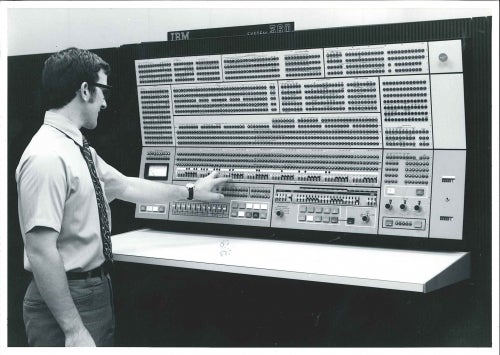
There’s a story that Don Cowan never gets tired of telling.
It’s about how an IBM 360/75 mainframe, the most powerful computer in Canada at the time, and the same model of computer that NASA would use to send astronauts to the Moon, was acquired and installed in a building that would house the University of Waterloo’s new Faculty of Mathematics.
“We somehow had decided that there would be a computer in the centre of the building,” Cowan said of the structure, which opened in 1968 and still stands on campus today as the Mathematics and Computer (MC) Building.
“Great, we can plan for a computer, but where’s it going to come from?”
His colleague and mentor, the late Wes Graham, pointed out that the Ontario government was funding 90 per cent of the cost of the building’s construction, and that this arrangement would also include furnishings for the building.
“Gee, a computer is furniture, isn’t it?” Cowan remembers Graham asking. “So, what have you got to lose? We put it in the proposal and, my God, we got it. And there was a $5-million building with $8 million worth of furniture.”
It was a caper to be proud of, even after other universities complained and the province made the University give some of the money back – under generous repayment terms, of course.
It was that sort of outside-the-box thinking that helped put Waterloo and its fledgling Department of Computer Science on the map. That Department, now the David R. Cheriton School of Computer Science, celebrates its 50th Anniversary in 2017.
Cowan can go on all day telling stories like that one. He came to Waterloo as a lecturer in 1960, before the IBM 360/75, and before there was a separate Mathematics faculty or a Department of Computer Science – a Department that he would lead in its infancy as its first chair.
Now a Distinguished Professor Emeritus, Cowan remembers the University’s first permanent computer, which arrived not long before he did. He was completing his master’s degree while lecturing, and he found the work tedious.
“If you’ve ever sat over a Monroe calculator and tried to grind out answers, anything that would make this simpler would be a good thing,” he said. “We had a computer then called the IBM 610, and the idea behind it was you would program it to do certain things, and then if you wanted to repeat the operation, it would punch a new tape. Except we couldn’t afford the tape, so we glued the ends together and it just kept going around, and that worked just fine.
“That was my first experience with computers. And then this computer showed up in April of ‘61, an IBM 1620.”
Cowan and a friend decided to try their luck on this new machine. He would eventually become an expert on it, but that process took a while.
“We didn’t know what the hell we were doing. We tried programming it, and we were highly unsuccessful, partly because the software was awful, and partly because we were awful. But I just became enamoured with the thing. I just found it fascinating,” he said.
“And then at the end of my master’s degree Ralph turned to me and said, ‘You know something about computers, would you like to stay around and help with the computers?’ I said sure. He doubled my salary – why not?”
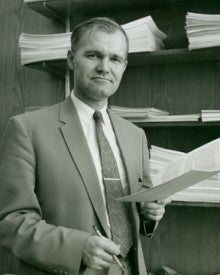
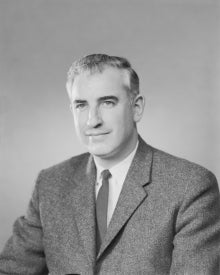
“Ralph” was Ralph Stanton, the first Chair of Mathematics at Waterloo. Mathematics was then only a Department within the Faculty of Arts, but Stanton (left) had big plans from the moment he arrived from the University of Toronto. Eventually those dreams would culminate with the separation of Mathematics into its own stand-alone faculty in 1967.
Stanton’s vision always included computers at the centre of the Faculty of Mathematics, and he hired bright young people to help bring his vision to fruition. One of those people was Wes Graham (right), whom Stanton had taught at U of T. Graham was working at IBM before he came to Waterloo, and this meant that he had industry-specific knowledge of what the University would need to establish itself as a centre of computing.
“I would say Ralph was a builder in the broader sense. He obviously wanted the computers here,” Cowan said. “Wes created the reputation for computing for Waterloo through his work. They were both incredibly powerful people, and both were mentors of mine for every year that they lived.”
Professor Scott Campbell is the Director of the University of Waterloo’s Centre for Society, Technology and Values. He’s also a Waterloo Computer Science graduate, and has become one of the Cheriton School of Computer Science’s de facto historians, along with colleague Lawrence Folland.
“It was just the right people who were here, who had an interest in these things,” Campbell said of early figures like Stanton and Graham, among many others.
“Stanton managed to attract a lot of key people very early and got a lot of momentum for Math and Computer Science so that they could build on any strength that they chose to. There’s no question that Graham was perceived as a leader here and was able to build his vision and turn it into reality of an entrepreneurial program while remaining committed to strong education.”
Graham is regarded today as the Father of Computing at Waterloo. He served as the first Director of the University’s Computing Centre, and it was under his leadership that lecturer Peter Shantz and a group of four undergraduate students – Gus German, Jim Mitchell, Richard Shirley and Bob Zarnke – spent the summer of 1965 writing a Fortran compiler that allowed users to quickly isolate and correct programming errors.
Compilers were important to student computing because they saved time, said David Taylor, a Professor Emeritus and former Director of the Cheriton School of Computer Science, who first came to Waterloo as a master’s student in 1973.
“They could run a program and get the results back fairly quickly, as opposed to waiting hours, which had been the norm previously,” Taylor said.
Although other Fortran compilers already existed in 1965, including one called FORGO, which had been acquired by Waterloo from the University of Wisconsin, the success of the four undergraduates in creating a faster and more reliable compiler of their own took faculty by surprise.
“Build a compiler in the summer? You’ve got to be kidding me. I didn’t think it was possible, but they did it,” Cowan said. “I was as big a skeptic as anybody, in that sense. The idea was wonderful, don’t misunderstand me – and it was damned good. That was WATFOR, for the IBM 7040.”
Another undergraduate team, led by lecturers Paul Cress and Paul Dirksen, built a new WATFOR compiler for the IBM 360/75 before the machine even arrived at Waterloo. By now, with word spreading of Waterloo’s success at compiler development, Wes Graham was being inundated with requests for copies of the compilers.
Graham, Cowan and others had come together in an informal research collective called the Computer Systems Group (CSG). The CSG began giving away copies of the software for free, but soon it was decided that a fee would be charged to cover distribution and ongoing maintenance costs. And yet the requests kept coming.
“Our group became almost like a little company inside the University. One year, we made $2 million,” Cowan said, adding the WATFOR compiler was distributed to educational, business and government users in at least 40 countries. A later compiler was called WATFIV. Other compilers would follow, many under Graham’s direction.
The CSG’s role in software marketing and distribution grew and was formally established within the University structure between 1969 and 1973. This entrepreneurial venture eventually led to the founding of WATCOM, or Watcom, the first of many spinoff companies from the University. These spinoffs in turn helped to cement Waterloo – the City as much as the University – as the tech hub that it is today.
“We were having fun. We were trying to solve problems that other people had attempted and made some progress on,” Cowan said. “Basically, the problem was to make computers easy for students to use. Up to that point in time, they weren’t. It was a lot of work to write a computer program and get it right.”
The Department of Applied Analysis and Computer Science was formalized as an administrative structure in 1967 when the Faculty of Mathematics was created. (“Applied Analysis” was dropped from the name in 1975.) Campbell said the founders of the Department were free to innovate simply because of its lack of history.
“They were perfectly timed to essentially take commodity hardware and do really interesting things with it,” he said, noting that this was the case in many such departments formed at around the same time. “There was no tether, there was no weight, there was no ball and chain behind them to drag them back. They could just jump right in and go.”
Cowan agrees that there was a sense at the time that anything was looked upon as possible. For example, after completing his master’s degree, he mused aloud one day about leaving to pursue a PhD. Ralph Stanton, who also happened to be the University’s Dean of Graduate Studies, overheard him.
“Ralph said, ‘Wait a few weeks, and we’ll start a program,’” said Cowan, who did in fact earn his doctorate in 1965 from the University of Waterloo. He never left Waterloo, other than for brief sabbaticals, and remains here today.
The same is true of Taylor, who intended to work in industry after completing his PhD at Waterloo in 1977. He was unable to secure the job he wanted at Bell Northern Research due to a hiring freeze, so he agreed to stay on campus and teach for a year. At the end of the year, BNR came calling, but by then Taylor had changed his mind.
“I decided that, really, the University was where I wanted to be rather than industry. So I decided that I would stay on here, and the Department in due course decided they would keep me. Rather by accident, I ended up spending my entire career here.”
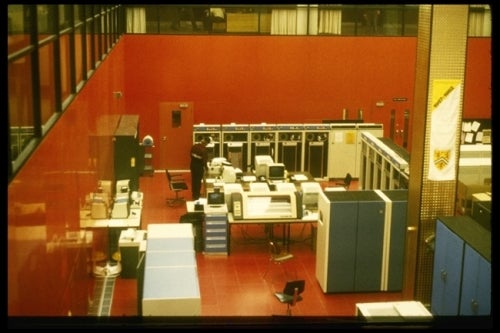
When Taylor arrived, a prominent feature of the Math and Computer Building was the Red Room, an enormous space on the first floor where the Department’s huge computers were housed. The room was literally red all over – on the walls, and the tile floors. Large windows on the second floor of MC allowed people to see the space where people worked on the IBM 360/75 and other machines.
“Computers were still physically big things, and there were not very many of them around,” Taylor said. “And so you brought a campus tour to the second-floor windows into the Red Room, and people got to look down at this array of physically really big stuff, and it was kind of awe-inspiring. Whereas now we have major computer power in our pants pockets. It’s just not the same thing any more.”
But for a long time it was a highlight of Computer Science Days, an outreach program started in the mid 1960s, designed to introduce children to computers. Students came from all over the province to tour the facilities, receive some basic programming instruction, and have the opportunity to write and run programs. By 1975, some 100,000 students per year were visiting campus for Computer Science Days.
When Taylor became Associate Chair of Undergraduate Studies in 1987, he remembered how effective Computer Science Days had been, and he arranged to have them revived for a new generation. It worked for a while, but eventually petered out as computers became more prominent in schools and homes. The Department of Computer Science could no longer easily show students things that they couldn’t do on their own.
Despite that, the Cheriton School of Computer Science has remained involved in such initiatives through the Canadian Association for Computer Science, which offers outreach activities. Faculty members participate in events and talk directly to students.
“The one thing that we can do, and still do do, is give them access to faculty members who are doing interesting things,” Taylor said, “to try to convince them that there are exciting things in computer science.
“It’s because computers have become so ordinary. It used to be that there was this kind of intrinsic wow factor, and ‘maybe I can be involved in that,’ but now it’s kind of, ‘since before I started elementary school, there have been laptops, tablet computers, phones. It’s just there, so why would I want to study that any more than I would want to study how to build a microwave?’ Trying to convince them that there are still fascinating things to be done is a theme.”
Outreach and promotion of Computer Science and the Faculty of Mathematics are traditions that goes back to the early 1960s, when Ralph Stanton and colleague Ken D. Fryer embarked on seemingly endless recruiting trips from one end of the province to another. They promoted the University to high schools, enticed students to come here through annual math contests, and connected with math teachers through the Society of Descartes Medallists, which was founded at Waterloo in 1968 to recognize and reward Ontario instructors for their excellence.
“It’s not like every university in the province gives prizes to high school math teachers for their contributions. I strongly suspect, although I don’t know for sure, that we’re the only one,” Taylor said. “So we’ve become the place that recognizes top-notch teaching and contributions to teaching in high school math. And that stems from this really deep connection to the high schools that was established at the very beginning.
“We really care about the high schools in a way that at least visibly doesn’t seem to be the case in a lot of other universities,” he added, noting that a happy byproduct of that connection is that teachers will invariably steer their strongest students toward Waterloo.
“We identify the best and the brightest. We get kids with vision, if you will,” Cowan agreed. “They’re not just bright, but they think and see that there’s a potential future. And then of course you turn them loose on a thing like co-op, once they’re in, and then they start to see all the things that could be done a lot better.”
Things have been getting better for decades, as mainframes like the IBM 360/75 have given way to microcomputers, laptops, and smartphones. Waterloo remained at the forefront of international software development while also establishing a number of research and development agreements and partnerships with hardware manufacturers like IBM, Hewlett-Packard, DEC, Commodore, and Apple.
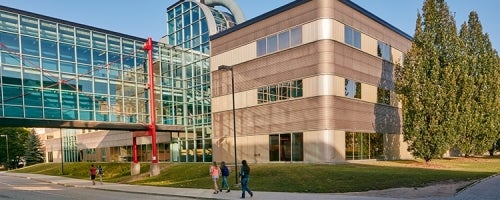
The Department of Computer Science eventually outgrew the Math and Computer Building and, in 1988, moved into the new William G. Davis Centre for Computer Research – known simply as the Davis Centre, or DC. It remains there today, still part of the Mathematics Faculty, even as it changed from a department to the School of Computer Science in 2002.
Another significant change took place in 2005 when the School was renamed after alumnus David R. Cheriton, the billionaire computer scientist, businessman and philanthropist who received his master’s degree and doctorate from Waterloo in the 1970s. The renaming was in acknowledgement of Cheriton’s $25-million investment in the School.
Watcom, founded in 1979 as Waterloo Basic Enterprises, was joined over the years by other prominent spinoffs. Waterloo Maple Software (now Maplesoft), the creator and manufacturer of the Maple computer algebra system, was founded in 1988. OpenText Corporation, which is now Canada’s largest software company, was founded in 1991. All remain in operation today in the City of Waterloo, reflecting their origins in Computer Science at the University.
With more than 80 faculty members, more than 3,000 undergraduate students and approximately 350 graduate students working in 16 distinct research areas, the Cheriton School of Computer Science is the largest concentration of academic research in Canada, and consistently ranked as one of the best such departments in the world.
“There’s certainly no other department in Canada that’s that big. There are very, very few in the United States that big, either,” Taylor said. “It gives us a huge breadth, and because the people on faculty are by and large very good, it also gives us a huge amount of strength collectively.”
But the School has never forgotten its roots. Campbell has worked to help commemorate its history by writing about it and by compiling items for a museum.
“There is value in appreciating the struggles of people who came before you,” he said.
“If you’re thinking about the past, you’re thinking about changes. It allows you to make those reflections. By looking at the whole context of what was going on, then you can really understand how these changes happen, and how you can participate and how you can plot the future that you want and figure out how to make the changes that you want to make.”
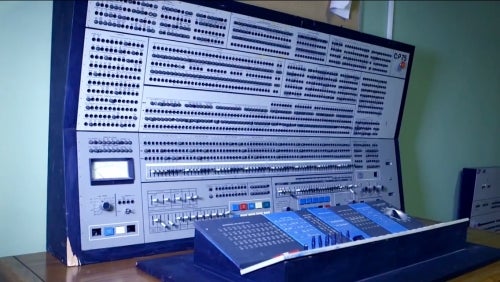
Campbell is adamant that a computing museum should not be confined to a single space in MC or DC, where the items may only collect dust. His goal is to create exhibits that will tell stories, using artifacts like that famous IBM 360/75 console, which, like the School it helped to launch, is turning 50 this year.
“The museum has to be something that makes a difference to other aspects of the University,” he said. “It can’t just be something to show off for alumni or for high school students. It has to be integrated into some sort of teaching curriculum, or it has to be involved in research programs.”
Cowan, who’s been a significant part of the entire history of computing at Waterloo, said there’s good reason to be celebrate and be proud of what has happened here.
“We were changing the world,” he said. “We didn’t realize we were changing the world, but we were trying to do things, and make things happen, and trying very much to engage with the undergraduate students. That’s where we could make our mark.
“There was an excitement here. We just wanted to make the place a world-beater, and it looks like we did.”




